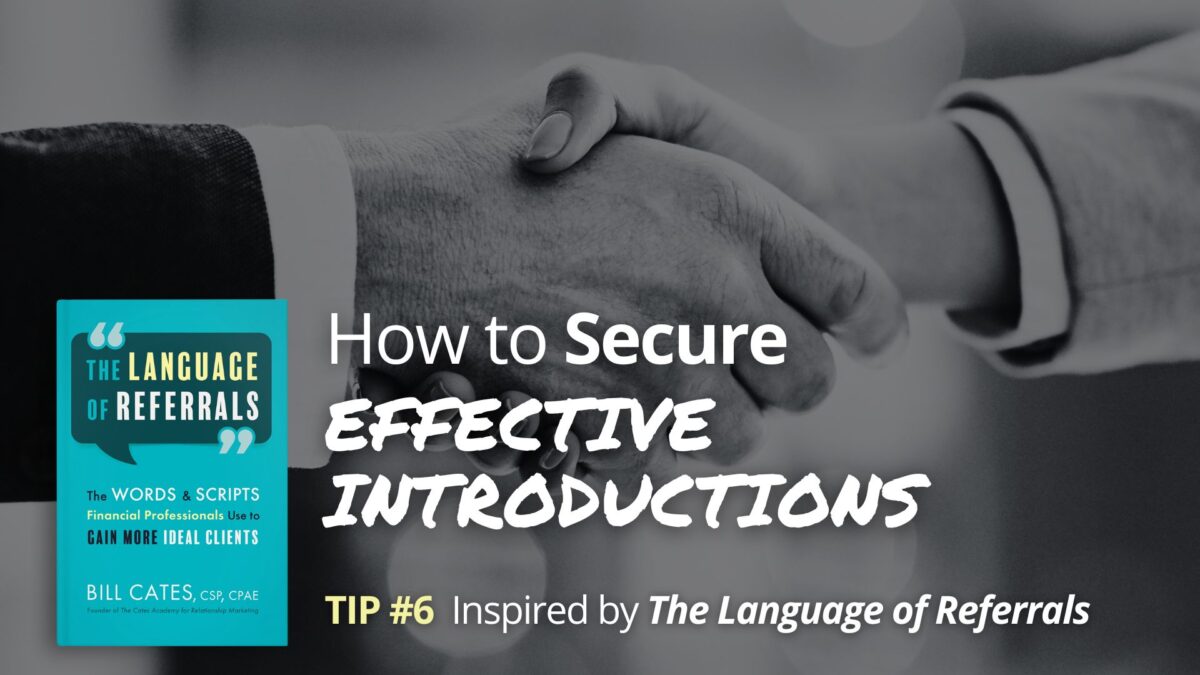Secure Effective Introductions

The Language of Asking for Introductions
Without Pushing, Begging, or Looking Like The Creepy Referral Guy
Excerpted from Bill’s new book…
The Language of Referrals: The Words & Scripts Financial Professionals
Use to Win More Ideal Clients
This article is Part 6 of a 6-part series. To access parts 1-5 CLICK HERE.
Having clients who are willing to refer is not the same as having clients working with you to create effective introductions. Your process is not complete until you get connected to your new prospect.
Although you can’t control exactly what your introducer will do or how the prospect will respond, there are a few things you can do to increase your chances of snagging an effective connection — one where the prospect will respond.
I’ll begin with 5 important principles for you to consider.
When you know the principles involved, you’ll find it much easier to figure out how to handle any situation that might arise.
Principle #1 is about protecting relationships.
While your introducer wants the connection to happen – they want to pay your value forward and probably like the idea of helping you in the process…. protecting their relationship with their friend, family member, or colleague is their primary concern.
Principle #2 is securing an effective introduction.
While you certainly respect your introducer’s priority of protecting their relationships, your primary concern is negotiating an introduction that sparks the prospect’s interest in speaking with you.
Principle #3 is about collaboration.
The introduction process needs to be a collaborative process between you and the introducer. You want to encourage your introducer to work with you to produce both a comfortable and effective introduction. Don’t be afraid to suggest your favorite way of being introduced. Just remain flexible to keep your introducer comfortable all along the way.
Principle #4 is about relevance.
A relevant introduction is essential. If the message conveyed to the prospect is not relevant to them, the message will likely be ignored. What your introducer says in the introduction and how you follow up must be as relevant to the new prospect as possible.
Principle #5 involves trust and credibility.
The trust and credibility between the introducer and prospect are critical. The best introductions typically contain a great deal of trust and respect between the introducer and the prospect.
Here are 2 important questions to ask your introducer:
- What’s going on in his/her/their life that’s important to them?
You know that money intersects and impacts every part of our lives. This is why learning about them and then referencing what’s going on that’s important to them in the introduction… and also incorporating that into your follow-up pretty much guarantees you’ll be bullseye relevant from the start. - How do you think they’ll respond to this introduction?
This question can often help you and the introducer create an introduction that will be well received. Your introducer may foresee one or more points of resistance coming from the prospect. You can work with your introducer to frame the introduction in a way that might reduce or eliminate any resistance.
There are so many ways you can be introduced to ideal clients. In-person events (business or social) is one of the best ways to get connected – as long as the logistics of making this happen don’t stall the process. Some advisors use 3-way Zoom introductions with great results.
My favorite way to be introduced and a method I’ve helped many advisors use effectively is what I like to call The Email Handshake.
The email handshake is efficient and protects relationships. Think of it this way. You’re having lunch with a friend. Another friend happens to enter the same restaurant. You introduce them to each other.
Michael, meet Marissa. She runs a very successful consulting business. Marissa, meet Michael. He’s been my financial advisor for years. One thing the two of you have in common is a passion for golf. We should all get together for a round sometime this year.
This same dynamic can be applied to an email introduction. For financial services, having the introducer tell the prospect WHY they are making this introduction adds to its effectiveness. In the example that follows, the client, George Jones, is introducing his friend Laura Smith to his financial professional, Bob Green.
The subject field might say: Introducing two great people.
And the message…
Laura, do you remember that conversation we had about retiring without having to take a pay cut? Well, I want you to meet Bob Green. Bob has been guiding Peggy and me through this process and he’s really opened our eyes to a few things we need to put in place to achieve our long-term goals. Most importantly, as we continue to work with Bob, we feel much more relaxed and confident about our financial future.
Bob, meet Laura. Laura and I have known each other for years. She’s one of the smartest and most well-connected people I know. She’s also a great golfer. If you guys play together, don’t bet any money. It won’t go well for you.
Laura, I highly recommend you speak with Bob. I’m sure it will be time well invested. If you like, maybe the three of us can meet for lunch next week.
As you can see, this is a pretty simple process. Many advisors like to create a template to give to the introducer to make it easy for the introducer to formulate an effective email handshake.
George, I have an example of what I have in mind that I’ll email to you. If you can emulate that template in some way, that would be perfect. Most of your words and details will be different, of course, but the example I provide should be helpful. How’s that sound?
[Your client might respond, I think I’ve got the idea but send the template. It will remind me! Happy to do this.]
Great. To make sure I don’t miss your email and so I can follow up appropriately, can you give me a sense of when you’ll be able to get to this? I want to keep an eye out for your email to Laura so I can respond promptly.
There are other types and methods for creating email introductions. With that said, what I just demonstrated is all you need to get started turning the willingness to refer into effective connections.
Do you have your own copy of The Language of Referrals?
It’s available in paperback, Kindle, and on Audible.
www.LanguageofReferrals.com
And don’t forget ALL our resources – many of them free – are waiting for you at www.ReferralCoach.com/resources.
Start Multiplying Your Best Clients with The Cates Academy™

Learn Bill Cates’ Proven Process to Attract More of the Right Prospects
The Cates Academy for Relationship Marketing™ is a comprehensive online video-training program that will help you generate significantly more income in less time. Work smarter, not harder!
Get the details and join us: www.CatesAcademyIndividuals.com



